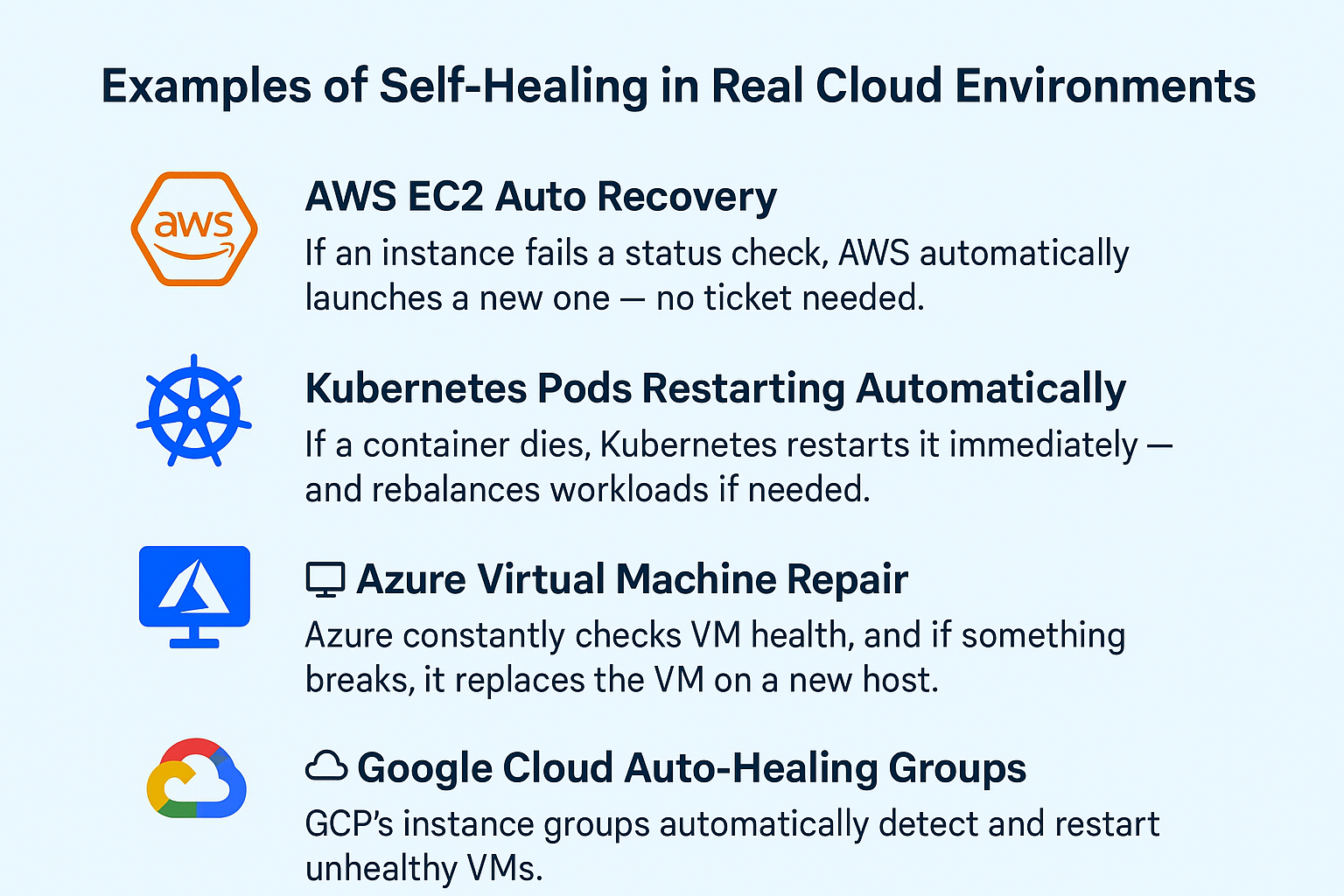Self-Healing Cloud Infrastructure Deployment: How to Build Systems That Fix Themselves
If your cloud systems still need a human every time something breaks, you're already behind.
Because with self-healing cloud infrastructure deployment, your servers, containers, and services can detect problems and fix themselves — in real time.
This guide breaks it all down.
You’ll see how modern DevOps teams deploy cloud infrastructure that auto-recovers from crashes, bugs, and failures — without needing a 3 a.m. emergency call.
Key Takeaways
-
Self-healing cloud infrastructure means your system can auto-detect and fix problems — no human required.
-
It uses monitoring tools, automation, and cloud-native services to stay online 24/7.
-
You can integrate self-healing with AWS, Azure, GCP, Kubernetes, and Terraform.
-
It saves money, reduces downtime, and increases developer productivity.
-
Companies like Innovaway help businesses deploy intelligent, cloud-based systems that self-heal and scale.
What Is Self-Healing Cloud Infrastructure Deployment?
Let’s break it down:
-
Cloud Infrastructure = Your virtual machines, containers, storage, and networking in the cloud.
-
Deployment = Setting all this up, usually via code (like Terraform).
-
Self-Healing = The system detects problems and fixes them automatically.
So instead of your app crashing and staying down, it:
-
Detects the crash
-
Replaces the failed service
-
Restarts everything
-
Sends you a notification — after it’s already fixed
This means less downtime, fewer headaches, and way better system resilience.
Why Self-Healing Infrastructure Is a Game-Changer
Let’s be real.
Downtime sucks.
It costs you customers, money, and reputation.
And human error is the #1 cause of outages in the cloud.
With self-healing infrastructure:
-
Your system fixes itself before users notice a problem
-
You stop wasting time on manual debugging
-
Your DevOps team focuses on building, not babysitting
According to Google Cloud, implementing automated recovery is key to hitting uptime SLAs and reducing operational stress.
Key Components of a Self-Healing Deployment
Let’s look at what makes this possible.
1. Monitoring & Observability
To fix a problem, your system needs to see it happen.
- Tools like Prometheus, Grafana, Datadog, and New Relic collect metrics and logs.
- They trigger alerts when something breaks — or is about to.
- Our ai powered proprietary tools setup @ innovaway.com
2. Automation Tools
You can’t heal a system with a Slack ping.
You need scripts, triggers, and playbooks to automatically:
-
Restart a service
-
Reroute traffic
-
Redeploy infrastructure
Popular tools include:
| Tool | What It Does |
|---|---|
| Terraform | Infrastructure as code + auto-healing with modules |
| Ansible | Automation of server tasks and config |
| Pulumi | Cloud deployments in modern languages |
| CloudFormation | AWS-native infrastructure automation |
3. Cloud Platforms
Your provider probably already supports self-healing:
| Provider | Self-Healing Feature |
|---|---|
| AWS | EC2 Auto Recovery, Elastic Load Balancing |
| Azure | VM Health Monitoring, Auto Repair |
| GCP | Instance Group Auto-Healing |
| Kubernetes | Self-healing pods and services |
These tools watch for health checks and automatically fix or restart components when they fail.
This is exactly what Innovaway helps organizations implement — building resilient, cloud-native environments that handle failures before they impact users.
Examples of Self-Healing in Real Cloud Environments
Let’s see what this looks like in practice.
- - AWS EC2 Auto RecoveryIf an instance fails a status check, AWS automatically launches a new one — no ticket needed.
- - Kubernetes Pods Restarting Automatically - If a container dies, Kubernetes restarts it immediately — and rebalances workloads if needed.
- 💻 Azure Virtual Machine Repair - Azure constantly checks VM health, and if something breaks, it replaces the VM on a new host.
- ☁️ Google Cloud Auto-Healing Groups - GCP’s instance groups automatically detect and restart unhealthy VMs.
Here’s a simple flowchart: User clicks a broken feature → Container crashes → Monitoring triggers alert → Auto-restart script runs → Service is back up in seconds.
Real Tools Powering This
Want to build your own self-healing cloud infrastructure?
These are your go-to tools:
| Category | Tool |
|---|---|
| Monitoring | Prometheus, Datadog, Grafana |
| Automation | Terraform, Ansible, Pulumi |
| Orchestration | Kubernetes, Docker Swarm |
| Cloud Services | AWS Auto Scaling, Azure Monitor, GCP Stackdriver |
And if you need expert help, Innovaway delivers robust, self-healing infrastructure design through its digital experience and SaaS solutions.
They work across AWS, Azure, and GCP to build systems that run smarter, not harder.

How to Build a Self-Healing Cloud Infrastructure
Here’s your step-by-step blueprint:
1. Define Failure Conditions
-
What counts as "broken"?
-
Is it CPU overuse? A failed ping? A crashed container?
Make it clear so automation knows what to look for.
2. Set Up Monitoring and Alerts
Use tools like Prometheus, Datadog, or CloudWatch to:
-
Track metrics (CPU, RAM, latency)
-
Log errors and stack traces
-
Fire alerts when thresholds are crossed
3. Automate Recovery Actions
Now connect the dots:
-
Use Terraform or Ansible to write scripts
-
Automatically restart a failed service
-
Scale up pods when traffic spikes
-
Roll back if a deployment fails
4. Test With Chaos Engineering
Break your system on purpose.
-
Kill pods, drop services, cut connections
-
Make sure your self-healing works under pressure
Tools like Gremlin and Chaos Monkey help here.
5. Integrate Into CI/CD Pipelines
Tie your healing into your build process:
-
Post-deploy health checks
-
Auto rollback if deploy fails
-
Slack alerts if multiple restarts occur
This is how Innovaway helps clients launch bulletproof cloud environments.
They integrate automation into every layer of deployment — so problems are solved before users even see them.
Tools and Frameworks That Enable Self-Healing Deployments
Here’s your self-healing toolbox:
| Tool | What It Does | Role |
|---|---|---|
| Terraform | Build infra via code | IaC + auto-rebuild |
| Kubernetes | Orchestrate containers | Restarts dead pods |
| AWS Auto Scaling | Adjusts EC2 size | Handles load spikes |
| Azure Monitor | Alerts + insights | Detects broken VMs |
| Pulumi | Cloud automation with code | Logic in JS/Python/Go |
| Ansible | Runs healing playbooks | Fix configs, restart services |
| Gremlin | Chaos testing | Ensures healing works |
Don’t just use one — combine them for full-stack resilience.
Best Practices for Self-Healing Cloud Systems
Want real results? Follow these best practices.
Use Declarative Infrastructure (IaC)
Write your infra like code.
If something breaks, it knows how to rebuild itself.
Monitor Everything
Track all the things:
-
Logs
-
Metrics
-
Network
-
App health
Because if you can’t see the problem, you can’t fix it.
Fail Fast, Heal Faster
Make small services.
Let them fail quickly — and recover even faster.
This is the microservices + auto-healing dream combo.
Automate Rollbacks
Don’t just deploy.
Watch the deploy.
If it crashes or slows down, roll back immediately.
Simulate Failure Often
Run failure drills.
Test healing with chaos engineering.
Make your system tough before production breaks it.
Real-World Case Studies
Netflix: Chaos Monkey & Friends
Netflix built a tool that kills random services in production.
Why? To make sure the rest of the system self-heals instantly.
Their whole Simian Army is based on chaos testing + automated recovery.
Shopify: Autoscaling Kubernetes
Shopify runs on Kubernetes.
During traffic spikes, it auto-heals failing pods and spins up more.
Zero crashes. Zero manual intervention.
🌐 Innovaway: Digital Experience Delivery
Let’s say Innovaway helps a global SaaS client.
Their platform:
-
Runs in AWS across 3 regions
-
Uses Kubernetes to host microservices
-
Monitors with Grafana and CloudWatch
-
Heals itself with Terraform + auto-scaling policies
The result?
99.99% uptime, less burnout for engineers, and a system that just… works.
Challenges of Self-Healing Infrastructure
This isn’t magic.
You’ll hit some bumps:
| Challenge | Fix |
|---|---|
| False Positives | Tune your thresholds |
| Complex Setup | Use templates or partner with Innovaway |
| Over-Automation | Always monitor what your automation does |
| Security Gaps | Harden scripts & don’t blindly restart critical services |
Keep control, even when systems heal themselves.
The Future of Self-Healing Infrastructure
This is just the beginning.
Here’s where it’s heading:
Predictive Healing
-
AI spots problems before they happen
-
Fixes them proactively
AIOps
-
Full automation of operations
-
AI-driven alerts, decisions, and remediations
NoOps
-
Systems run and heal themselves
-
No humans needed to deploy, monitor, or repair
Self-healing is step 1.
The end goal? Autonomous infrastructure.
FAQs
What is self-healing infrastructure?
It’s cloud infrastructure that detects failures and automatically fixes itself — no humans needed.
Is it expensive?
Not really.
The upfront setup costs less than constant outages and DevOps stress.
And with tools like Terraform, Kubernetes, and AWS Auto Recovery, most features are built-in.
Can small companies do this?
Yes.
Use:
-
Kubernetes for container healing
-
Cloud-native features (like Azure Monitor)
-
Innovaway’s managed cloud services for enterprise-level healing
What are the risks?
-
Over-relying on automation
-
Poorly configured health checks
-
Hidden costs if healing masks root causes
Just build smart and test often.
How does Innovaway help?
Innovaway designs and deploys resilient, scalable, self-healing infrastructure for companies worldwide.
From automation to optimization, they help SaaS and cloud-based platforms run faster, recover faster, and perform better — no matter what happens.
Final Thoughts
You’re not trying to avoid failure.
You’re designing a system that recovers instantly when it happens.
That’s what self-healing cloud infrastructure deployment is all about.
Less firefighting.
More uptime.
Smarter systems.
It’s not the future — it’s happening right now.
Lets get in touch
